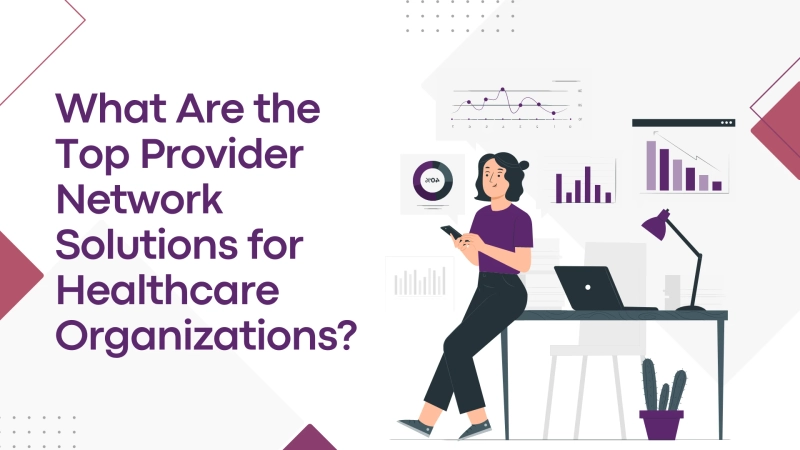Introduction: Understanding Provider Network Solutions
Healthcare organizations face numerous challenges in managing provider networks efficiently, including optimizing network performance, ensuring patient access to care, and controlling costs. Provider network solutions encompass a range of technologies and strategies designed to address these challenges and improve overall network effectiveness.
Challenges in Provider Network Management
Managing provider networks is a multifaceted endeavor that encompasses a range of complex tasks, from credentialing and contracting to care coordination and quality assurance. These tasks can be challenging to streamline without the right tools and processes in place. Healthcare organizations must navigate a myriad of challenges, including regulatory requirements, interoperability issues, and evolving patient needs and market dynamics.
Credentialing providers involves verifying their qualifications, licenses, and certifications to ensure they meet the standards set by regulatory bodies and insurance companies. This process can be time-consuming and labor-intensive, requiring meticulous attention to detail and compliance with stringent guidelines.
Contracting with providers involves negotiating agreements that outline payment rates, service offerings, and performance metrics. Healthcare organizations must strike a delicate balance between controlling costs and maintaining high-quality care, all while adhering to regulatory mandates and contractual obligations.
Care coordination is essential for ensuring seamless transitions of care and optimizing patient outcomes. However, coordinating care among multiple providers and healthcare settings can be challenging, particularly in fragmented healthcare systems with disparate electronic health record (EHR) systems and communication protocols.
Additionally, healthcare organizations must contend with regulatory requirements imposed by government agencies, such as the Centers for Medicare & Medicaid Services (CMS) and the Health Insurance Portability and Accountability Act (HIPAA). Compliance with these regulations is non-negotiable and requires ongoing monitoring and adherence to ensure patient safety and data security.
Interoperability issues further compound the challenges of provider network management, as disparate EHR systems often struggle to exchange information seamlessly. This lack of interoperability can hinder care coordination efforts, impede data sharing, and compromise patient safety.
Furthermore, healthcare organizations must adapt to evolving patient needs and market dynamics, including shifts in demographics, consumer preferences, and healthcare delivery models. Staying agile and responsive to these changes is crucial for maintaining a competitive edge and meeting the needs of diverse patient populations.
The Importance of Effective Provider Network Solutions
Effective provider network solutions are essential for healthcare organizations to deliver high-quality care, enhance patient satisfaction, and achieve operational efficiency. By leveraging innovative technologies and best practices, organizations can optimize network performance, improve care coordination, and drive better outcomes for patients and providers alike.
1. Data Analytics for Network Optimization
Data analytics tools enable healthcare organizations to analyze vast amounts of clinical and operational data to identify trends, patterns, and opportunities for improvement within provider networks. By leveraging data-driven insights, organizations can make informed decisions to optimize network performance, enhance care delivery, and achieve cost savings.
2. Telemedicine Integration for Enhanced Care Delivery
Telemedicine platforms facilitate remote consultations, virtual visits, and remote monitoring, enabling healthcare organizations to expand access to care and improve patient engagement. Integrating telemedicine into provider networks enhances care coordination, reduces unnecessary hospital visits, and improves patient outcomes, particularly in rural or underserved areas.
3. Artificial Intelligence in Provider Network Management
Artificial intelligence (AI) applications, such as predictive analytics and machine learning algorithms, can analyze healthcare data to identify inefficiencies, predict patient needs, and optimize provider network workflows. AI-driven solutions enable proactive decision-making, personalized care delivery, and operational efficiency improvements across the care continuum.
4. Blockchain Technology for Secure Data Sharing
Blockchain technology offers secure and transparent data management solutions, enabling healthcare organizations to securely share patient information across provider networks while maintaining data integrity and privacy. By leveraging blockchain, organizations can streamline administrative processes, reduce data breaches, and improve care coordination.
Selecting the Right Provider Network Solution
Choosing the appropriate provider network solution is a critical decision for healthcare organizations, as it directly impacts the efficiency, effectiveness, and quality of care delivery. To make an informed choice, organizations must consider several key factors:
1. Assessing Organizational Needs
Before selecting a provider network solution, healthcare organizations should conduct a thorough assessment of their unique challenges, priorities, and goals related to provider network management. This evaluation involves engaging stakeholders from various departments and levels of the organization to gain insights into current pain points, workflow inefficiencies, and areas for improvement. By understanding their specific needs and requirements, organizations can identify the most suitable solutions that address their challenges and align with their strategic objectives.
2. Evaluating Solution Features and Benefits
Once organizational needs have been identified, healthcare organizations should evaluate the features, functionalities, and benefits of different provider network solutions. This evaluation should encompass factors such as scalability, flexibility, interoperability, and ease of use. Key features to consider include credentialing and contracting capabilities, care coordination tools, analytics and reporting functionalities, and interoperable communication channels. By assessing the alignment between solution features and organizational requirements, healthcare organizations can determine which solution best meets their needs and objectives.
3. Cost Considerations and ROI Analysis
Cost is a critical factor in the selection of provider network solutions. Healthcare organizations should conduct a comprehensive cost-benefit analysis to evaluate the total cost of ownership and the return on investment (ROI) associated with each solution. This analysis should take into account not only the initial implementation costs but also ongoing maintenance, support, and training expenses. By weighing the costs against the anticipated benefits and long-term value proposition of each solution, organizations can make informed decisions that align with their budgetary constraints and financial goals.
Implementing Provider Network Solutions
Successful implementation of provider network solutions requires careful planning, execution, and ongoing support to ensure smooth adoption and integration into existing workflows:
1. Integration with Existing Systems
Integration with existing systems, workflows, and processes is essential for seamless implementation and minimal disruption to operations. Healthcare organizations should carefully assess the compatibility of new provider network solutions with their current technology infrastructure and data management systems. This may involve customizing interfaces, developing APIs for data exchange, and configuring interoperable communication channels to facilitate seamless integration. By proactively addressing integration challenges, organizations can maximize efficiency and optimize the value of their provider network solutions.
2. Staff Training and Change Management
Effective implementation of provider network solutions hinges on comprehensive staff training, change management, and ongoing support. Healthcare organizations should invest in training programs to familiarize staff with the functionalities, workflows, and best practices associated with the new solution. Additionally, change management strategies should be employed to address staff resistance to change, foster buy-in, and promote a culture of innovation and continuous improvement. By providing adequate training and support, organizations can empower staff to leverage the full potential of provider network solutions and drive positive outcomes for patients and providers alike.
Future Trends in Provider Network Solutions
Emerging technologies and innovative approaches to healthcare delivery will shape the future of provider network solutions. Predictive analytics holds promise for improving decision-making and resource allocation within provider networks. By analyzing vast amounts of data, including patient demographics, clinical outcomes, and utilization patterns, predictive analytics can identify trends and anticipate future healthcare needs, enabling proactive interventions and strategic planning.
Remote monitoring technologies offer opportunities for enhancing care coordination and patient engagement within provider networks. By leveraging wearable devices, mobile apps, and telehealth platforms, healthcare organizations can remotely monitor patients\' vital signs, medication adherence, and disease management, facilitating early intervention and personalized care delivery.
Interoperable platforms that enable seamless data exchange and communication among providers and healthcare systems will play a critical role in overcoming interoperability challenges. By standardizing data formats and communication protocols, interoperable platforms promote care coordination, improve data sharing, and enhance the overall efficiency of healthcare delivery.
In summary, the future of provider network solutions is characterized by innovation, collaboration, and a relentless focus on improving patient outcomes. By embracing emerging technologies and leveraging advanced solutions, healthcare organizations can overcome the challenges of provider network management and drive better outcomes for patients and providers alike.
Conclusion: Empowering Healthcare Organizations with Effective Solutions
In conclusion, provider network solutions play a crucial role in helping healthcare organizations overcome challenges, optimize network performance, and deliver high-quality care. By leveraging technologies such as data analytics, telemedicine, AI, and blockchain, organizations can enhance care delivery, improve patient outcomes, and achieve sustainable growth in today\'s dynamic healthcare landscape.
FAQs: Addressing Common Questions About Provider Network Solutions
Q1. What are provider network solutions, and why are they important for healthcare organizations?
Provider network solutions encompass technologies and strategies designed to optimize network performance, improve care delivery, and enhance patient outcomes, addressing key challenges in provider network management.
Q2. How can data analytics benefit provider network optimization?
Data analytics enables healthcare organizations to analyze clinical and operational data to identify trends, patterns, and opportunities for improvement within provider networks, driving informed decision-making and operational efficiency.
Q3. What role does telemedicine play in provider network management?
Telemedicine integration expands access to care, enhances care coordination, and improves patient engagement by facilitating remote consultations, virtual visits, and remote monitoring within provider networks.
Q4. How does artificial intelligence contribute to provider network optimization?
Artificial intelligence applications, such as predictive analytics and machine learning algorithms, enable proactive decision-making, personalized care delivery, and operational efficiency improvements within provider networks.
Q5. What considerations should healthcare organizations keep in mind when selecting provider network solutions?
Healthcare organizations should assess their specific needs, evaluate solution features and benefits, consider cost implications, ensure seamless integration, provide staff training, and stay informed about emerging trends to select the most suitable provider network solutions.


